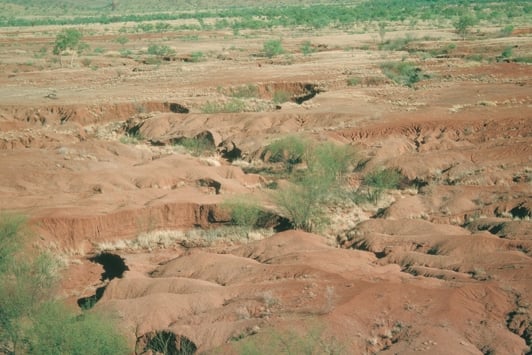The department provides the following information to help land managers and landholders to reduce the risk of water erosion following a fire.
First steps after a fire
- Minimise soil disturbance caused by vehicle and livestock traffic - disturbed soil on bare ground is highly susceptible to water and wind erosion.
- Check and repair surface water management structures upslope of burnt areas. If you don't have surface water management structures, this is a good time to plan where they should go.
- Prevent contamination of water resources by paddock residues and silt.
Prevent silt and other material being washed into dams and other water resources
Sediment fences reduce contamination of water bodies by trapping sediments, ash, and organic material before they can enter dams and water resources. They are cheap and effective. Temporary sediment fences can be removed after sufficient ground cover has established, following the break of season. Refer to the Agriculture Victoria video, Building sediment fences.
Prevent future contamination by constructing and maintaining silt traps at the dam entry point. Use roaded catchments, fenced to exclude stock, to harvest water and minimise contamination risk. At the break of the season:
- Defer grazing on pastures until there is at least 50% groundcover, and feed on offer reaches 500 to 800 kilograms of dry matter per hectare. On highly susceptible areas (for example, steep slopes, and long water accumulation runs) aim for at least 70% ground cover before grazing.
- Minimise soil disturbance when sowing a crop. Refer to Developing a controlled traffic (tramline) farming system, which helps contain any vehicle disturbance.
- Establish early cover crops on the most susceptible land – oats are generally recommended.
In the following year
Identify any areas that had water erosion following the fire, and plan and build water erosion control earthworks and permanently grassed waterways to mitigate erosion on the highest risk landscapes.
Areas at risk
Areas at greatest risk from water erosion following a fire include:
- long slopes
- steep slopes and rocky areas
- access tracks
- tramlines running downslope in controlled traffic systems
- drainage depressions on sloping land
- culvert exits where water becomes concentrated
- anywhere with existing or past erosion.
Problems from water erosion after a fire
These problems are mostly the same as for any water erosion:
- sheet, rill and gully erosion
- nutrient loss
- sediment build-up in banks and dams – desilting may be required
- contamination of water supplies with ash and burnt vegetation; see water supply management following a fire for more information
- damage to fences, tracks and other infrastructure
- reduced ability to access paddocks.
Being prepared for fire
Dealing with water erosion after a fire is recommended part of a farm planning that includes fire and whole-farm water management.
Refer to Prepare for a bushfireContact us
-
Paul GallowayFisheries and Agriculture Resource Management Senior Research Scientist

